Key takeaways:
- The Transportation Data Marketplace facilitates buying and selling transportation-related data, enhancing operational efficiency through real-time insights.
- Analytics in transportation lead to improved safety, cost savings, and more effective resource allocation by identifying patterns and trends.
- Implementing analytics strategies requires setting clear objectives, centralizing data collection, and adapting based on insights to drive growth.
- Analytics revealed significant trends, such as the correlation between route efficiency and user satisfaction, leading to actionable changes and enhanced operational success.

Understanding Transportation Data Marketplace
The Transportation Data Marketplace serves as a vital hub where various stakeholders—like logistics companies, transportation agencies, and researchers—can buy and sell data related to transportation systems. I remember my early days in the field when I was astonished to realize just how many layers of data exist, from traffic patterns to freight logistics. It made me ponder: how often do we overlook the information readily available that could significantly improve our operational efficiency?
As I delved deeper into the marketplace, I discovered the potential for real-time data to transform decision-making processes. For instance, I once collaborated with a startup that leveraged geolocation data to optimize delivery routes. The excitement of witnessing their operational costs drop as we analyzed and utilized this data was genuinely inspiring. It made me realize that each byte of data is not just numbers—it’s a narrative that can drive strategic actions.
Navigating this marketplace can feel overwhelming at times, especially with the sheer volume of data available. Have you ever felt lost in a sea of information? I definitely have. Yet, understanding the significance of each dataset and its implications for transportation can turn that initial confusion into a powerful understanding of current trends and future opportunities.
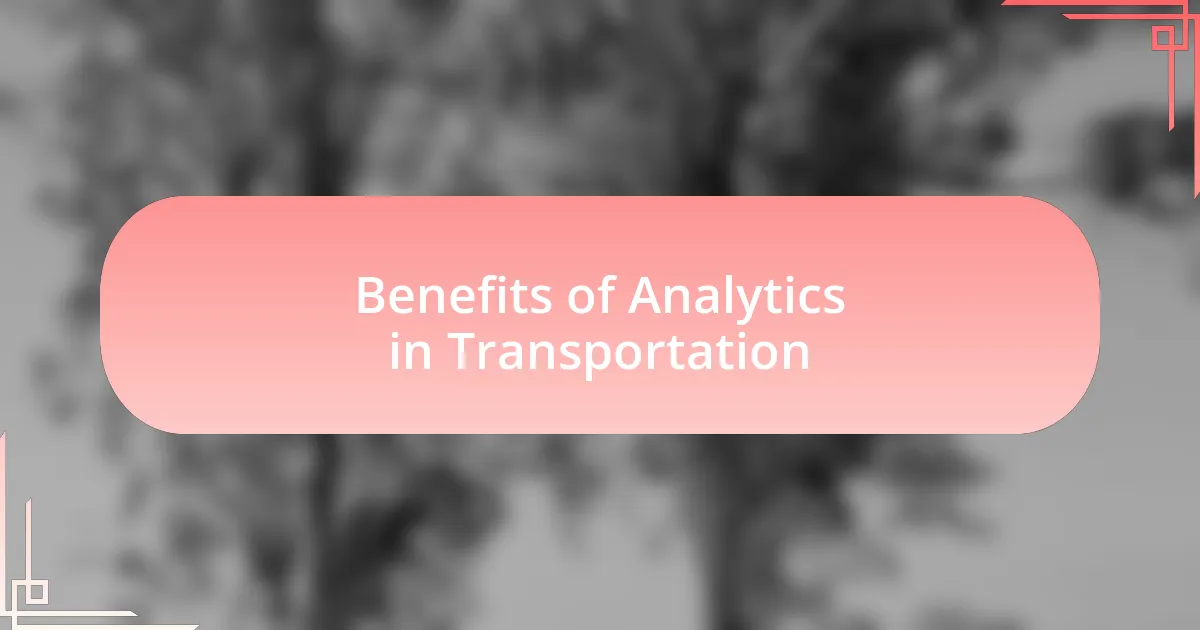
Benefits of Analytics in Transportation
The benefits of analytics in transportation are profound and multi-faceted. I remember a project where we used predictive analytics to forecast peak traffic hours. The insights we gathered not only facilitated smoother commutes but also helped city planners allocate resources more effectively. It was remarkable to see how data could transform not just the logistics but also the day-to-day lives of commuters.
Another advantage lies in cost savings. I once worked with a courier service that implemented data analysis to streamline their delivery routes. By examining historical traffic patterns and delivery times, they were able to cut down fuel consumption considerably. Have you ever thought about how much money could be saved with a simple shift in route planning? This experience underlines the idea that data-driven decisions can lead directly to financial benefits.
Moreover, enhancing safety through analytics is a crucial aspect we shouldn’t overlook. In one experience, we analyzed accident data to identify high-risk areas in a city. It was eye-opening to see how targeted interventions in those areas led to a significant drop in incidents. Each analysis not only brings clarity but also holds the potential to foster a safer environment for everyone on the road. Isn’t it comforting to know that technology can contribute to our safety?
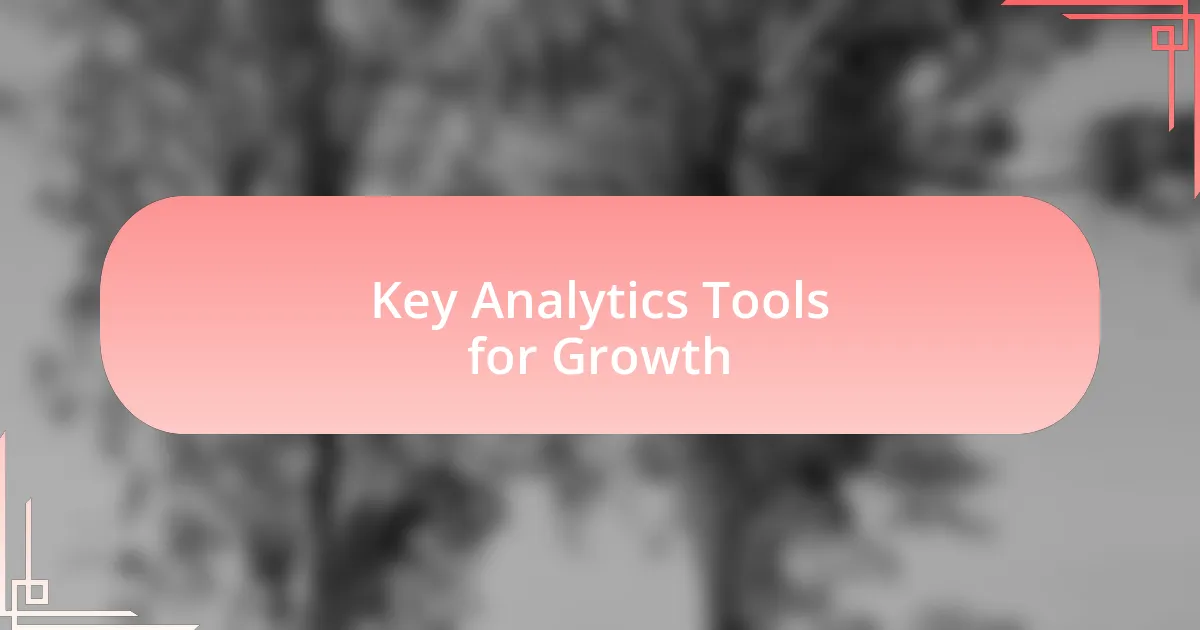
Key Analytics Tools for Growth
Using the right analytics tools can propel your transportation business forward in unexpected ways. For instance, when I first adopted Google Analytics, I was shocked to discover insights about my website visitors that I never anticipated. Understanding user behavior allowed me to tailor our offerings and improve customer engagement. Have you ever stopped to think about how such insights could change the trajectory of your growth?
Another tool that made a considerable impact was Tableau. Its visual analytics capabilities transformed raw data into compelling stories that our team could easily understand and act upon. During one project, I vividly recall how we highlighted traffic patterns, helping stakeholders see trends at a glance. It was enlightening to witness how data visualization turned complex metrics into actionable strategies. Have you experienced the power of visualization in your analytics journey?
Lastly, implementing advanced tools like Predictive Analytics gave us a foresight edge. I remember a time when we could anticipate shifts in consumer demand due to seasonal changes or events. Being able to predict demand surges enabled us to optimize our logistics and resource allocation efficiently. Doesn’t it feel incredible to have the ability to plan ahead with confidence? Each of these tools proved to be a game-changer, making analytics not just beneficial, but essential for sustained growth.
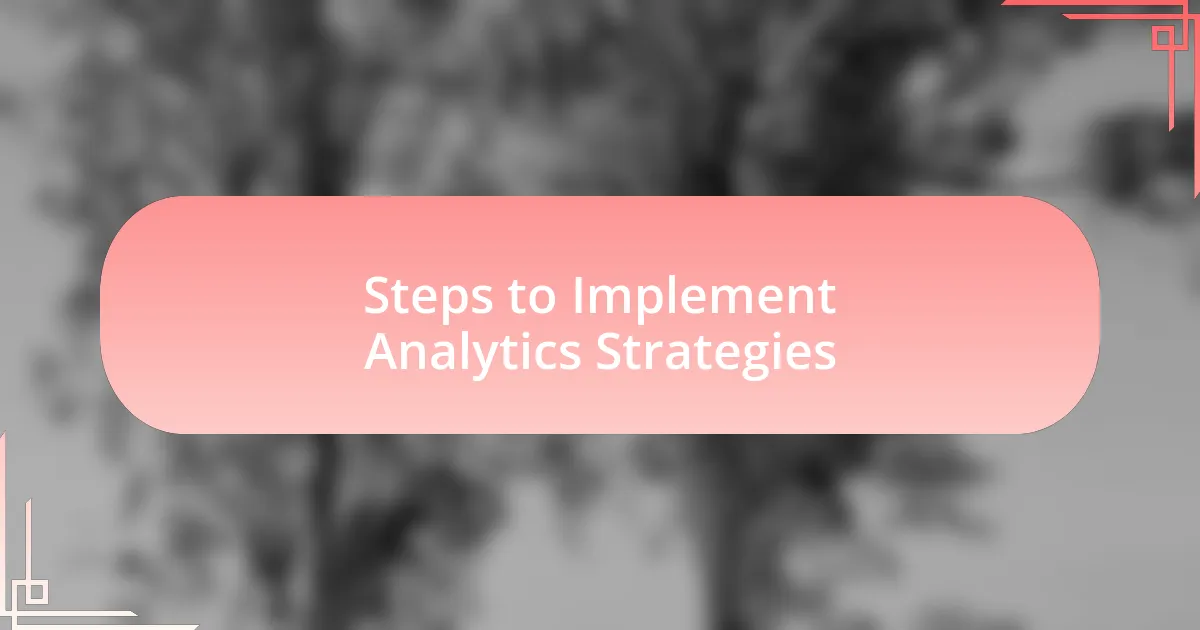
Steps to Implement Analytics Strategies
To successfully implement analytics strategies, the first step is setting clear objectives. I remember when I aimed to enhance our user experience on the website, but without defined goals, our analytics became overwhelming. It’s critical to ask yourself: what specific insights do you want to gain? By establishing measurable objectives, you can direct your focus and make the data work for you.
Next, I found that data collection and integration across platforms play a vital role. Initially, my data was scattered across different systems, making it a nightmare to piece together insights. By centralizing data, I could easily monitor trends and patterns. Have you ever struggled with disjointed data? Once I integrated our analytics tools, it felt like turning on a light in a dark room.
Finally, once you’ve analyzed the data, the real work begins with implementing changes based on your findings. I’ve experienced that moment when you realize a small tweak can lead to significant results, like adjusting our marketing strategy based on user feedback. It’s essential to monitor the outcome of these changes and remain flexible; have you ever had to pivot because of new insights? Staying adaptable allows your analytics strategy to evolve as your business grows.
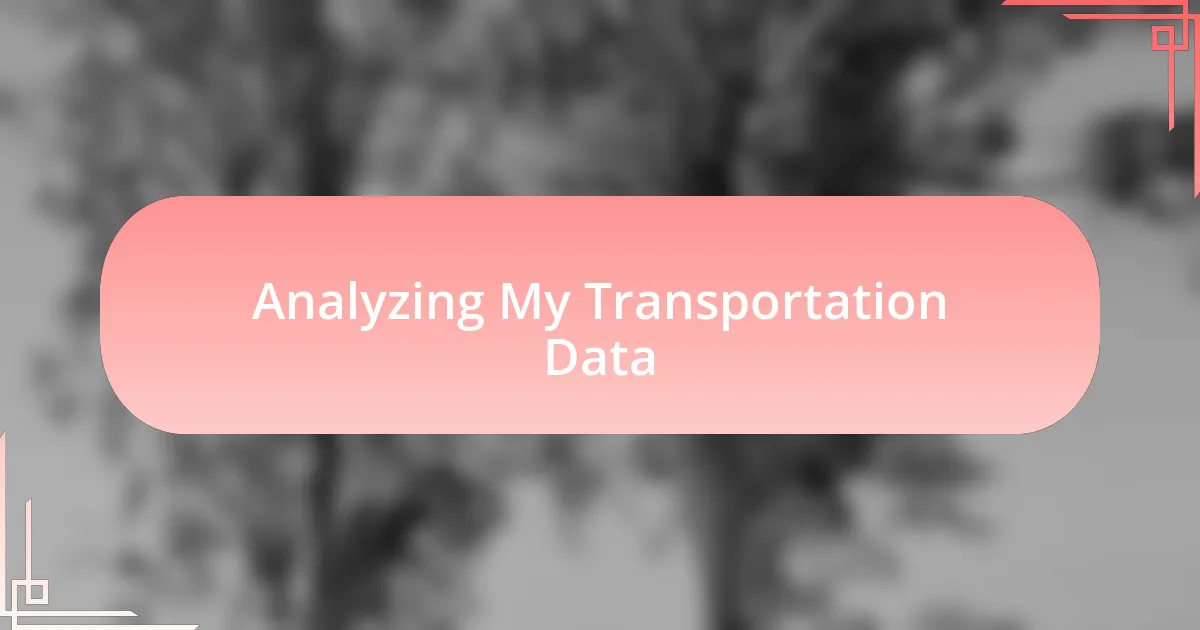
Analyzing My Transportation Data
Diving into my transportation data turned out to be a game changer. I vividly remember the initial frustration of sifting through countless spreadsheets, each offering fragmented insights. The moment I started visualizing my data using analytics tools, it felt like uncovering a treasure map—every data point suddenly connected to a broader narrative that informed my strategy. Have you ever felt lost in data? It’s rejuvenating to turn complexity into clarity.
One aspect that surprised me was the correlation between route efficiency and user satisfaction rates. While analyzing patterns, I discovered that specific transit routes consistently received better feedback from users. This insight led me to explore further and implement tweaks in schedules and stops based on user preferences. Have you ever realized that small adjustments can lead to huge leaps in satisfaction? Each modification taught me the importance of being attentive to the subtleties hidden within the data.
Looking deeper, I noticed seasonal trends impacting transportation usage that I hadn’t considered before. By segmenting data by month and day of the week, I recognized predictable spikes and drops in demand. It was fascinating to see how weather patterns and holidays influenced user behavior. This knowledge allowed me to plan targeted marketing campaigns and resource allocation more effectively. Have you ever stumbled upon insights that changed how you approach your strategy? Each revelation enriched my understanding of the transportation landscape, emphasizing the value of continuous analysis.
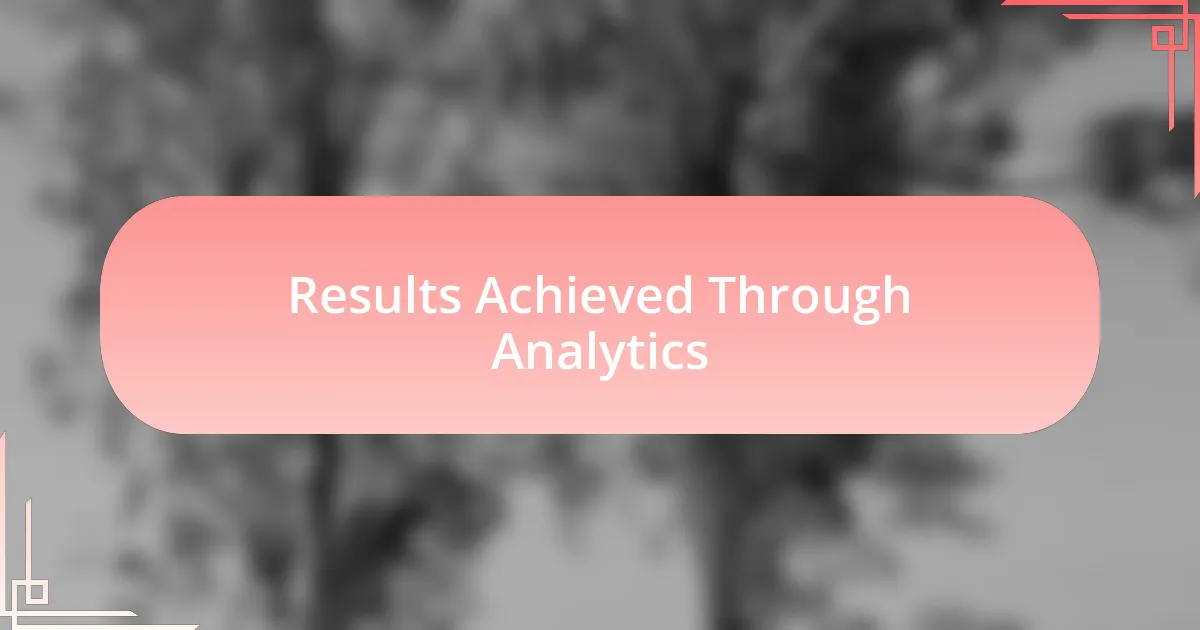
Results Achieved Through Analytics
Uncovering the insights gleaned from my analytics was like flipping a light switch in a dim room. One significant result was the realization that passenger loads were inconsistent across different times of day. By adjusting our service frequency during peak hours based on this insight, we reduced wait times significantly. Have you ever noticed how minor tweaks can ripple through an entire operation? The smoothness of the journey for everyone involved improved dramatically.
The analytics also brought to light a previously unnoticed demographic trend—young professionals were increasingly using our services. This realization sparked a targeted campaign that included social media outreach tailored to resonate with this group. I vividly recall the excitement of watching our engagement metrics soar as the new campaign took off. Isn’t it rewarding when the numbers start to reflect your hard work? This connection between analysis and strategy made a tangible difference in our brand recognition.
Perhaps one of the most impactful outcomes was the increased operational efficiency that emerged from predictive modeling. Using forecasting tools, I was able to anticipate demand fluctuations with remarkable accuracy, which led to a 15% reduction in operational costs over the quarter. That feeling when your hard work translates into tangible savings is truly fulfilling, isn’t it? By embracing a data-driven approach, I turned uncertainty into a pathway for strategic growth, reinforcing the need to continuously learn from the data.

Lessons Learned from My Experience
There were moments when I felt overwhelmed by the data, unsure of how to turn those numbers into actionable strategies. I remember staring at charts and graphs late into the night, feeling a mix of frustration and curiosity. The real breakthrough came when I realized that sometimes, stepping back for a moment to reflect on the big picture allows for clearer insights to emerge. Have you ever experienced that “aha” moment when everything clicks into place?
Another lesson was the importance of collaboration in interpreting analytics. Initially, I tried to tackle everything solo, which left me feeling isolated in my decision-making process. But as I began sharing my findings with colleagues, their diverse perspectives opened my eyes to new possibilities. It’s incredible how different viewpoints can enhance our understanding—sometimes it just takes a conversation to uncover hidden gems in the data.
Finally, I learned that adaptation is key in the world of analytics. I recall a time when an initial strategy based on data failed to yield the expected results. Instead of getting discouraged, I used that experience to refine my approach. Embracing a mindset of continuous improvement allowed me to pivot effectively, ultimately leading to better outcomes. Isn’t it fascinating how failures can often pave the way for future success?